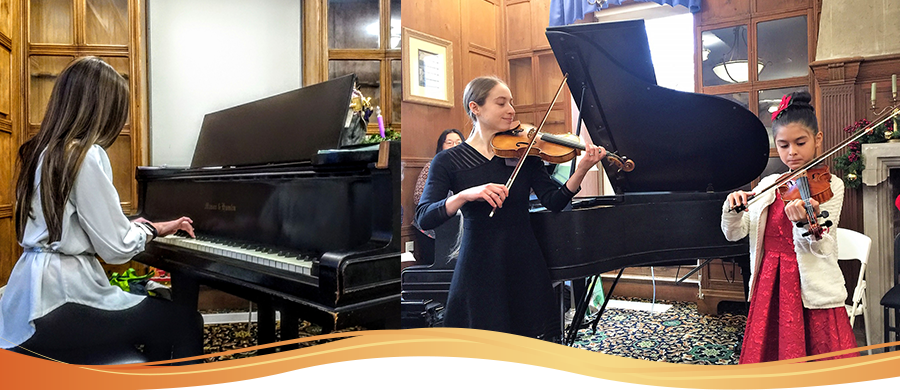
Online
Music for the Community
If you're interested in a particular category, you can sort performances by student age, instrument, singalong music, composer and so on - click on the orange tags under the text. We hope you and your family will enjoy watching our students share their music!
To have each week's videos and accompanying info sent to your inbox*, please subscribe via the orange button.
*Videos are delivered twice weekly; you can unsubscribe at any time, and we will never share or sell your info.
Subscribe to this Page
Day 28: Etude by Suzuki (Skills, part 3)
Violinist age 8 plays Etude by Suzuki
Day 27: Go, Tell Aunt Rhody (Skills, part 2)
Violinist age 8 plays Go Tell Aunt Rhody
Day 26 - Early Beginners play Twinkle (Skills, part 1)
We're doing something a little different this week - taking you on a journey from the earliest stages of learning an instrument through to musical mastery. First, our beginners who are just learning to pick out a simple tune...
Pianists age 4 play Twinkle, right hand and left hand
Day 25: "Spring" from Vivaldi's Four Seasons
Violinist age 9 plays "Spring" from Vivaldi's Four Seasons, first movement
We’ve finally had some great spring days over the past week – we hope you’ve managed to get outside and enjoy them! With spring really getting underway, this seems like the perfect time to offer this beautiful sound picture.
Italian composer Antonio Vivaldi lived from 1678 – 1741 (more or less at the same time as Bach), and his "Four Seasons" violin concertos are among his most beloved compositions. Each movement of each season is paired with a poem, and it’s thought that Vivaldi may have written these too.
Here’s his poem for this first movement of the "Spring" concerto - and where in the video you'll hear the matching music:
Springtime is upon us. [opening theme]
The birds celebrate her return with festive song, [00:36]
and murmuring streams are
softly caressed by the breezes. [1:25]
Thunderstorms, those heralds of Spring, roar, [thunder at 2:03, lightning at 2:06, rain at 2:14 on]
casting their dark mantle over heaven,
Then they die away to silence, [2:43 - 2:53]
and the birds take up their charming songs once more. [2:53]
Painting the full picture takes a lot of notes - you might notice the young violinist moving over from one page to the next a couple of times!
Day 24: Down Pony, Up Pony
Violinist age 5 plays Twinkle Variation C, "Down Pony, Up Pony"
Here is another variation on Twinkle, from one of our young Wayland Rec beginners. Again, this bowing pattern will show up later in much more advanced repertoire.
For violin, viola and cello, we call this variation “DOWN pony, UP pony” to emphasize the alternating direction of the strong bow strokes. Others like to call it “Long, short-short, Long, short-short”, while our Suzuki piano teachers often use “Run Mommy, Run Daddy”. Pick one of these, and see if you can keep up singing it all the way through - or maybe chase Mom and Dad around the house!
Day 23: Beethoven’s “Für Elise"
Pianist age 11 plays Beethoven’s “Für Elise (For Elise)”
Who was the mysterious Elise for whom Beethoven wrote this short but very famous piece? There are quite a few possible candidates!
One is German soprano Elizabeth Rockel, who sang in Beethoven’s opera Fidelio. She met with Beethoven quite often, and it’s known that he wanted to marry her at one time. Another soprano called Elise Barensfeld has also been suggested, although less is known about her.
But in fact, what Beethoven actually wrote on the manuscript was not "Für Elise" - but "Für Therese"! It’s widely acknowledged that the Therese in question was Therese Malfatti, to whom Beethoven proposed marriage in 1810, the same year he composed the piece. As further evidence, she was also the owner of the manuscript.
She must have been rather put out when - thanks to a sloppy copywriter who made the 19th century equivalent of a typo - her name on the published version of the work was changed to someone else’s!
Day 22: Mary had a Little Lamb
Flutist age 6 plays Mary had a Little Lamb
Day 21: Allegro Appassionato by Saint-Saens
Cellist age 16 plays Allegro Appassionato by Saint-Saens
French composer Camille Saint-Saens (pronounced Sanh-Sonh) was born in Paris in 1835. By the time he was three he was picking out tunes on the piano, and his great-aunt started teaching him. He made his professional debut at the age of 10, and also became a brilliant organist.
His first job was as a church organist, which allowed him time to pursue his interests in piano and composing. He later became a beloved teacher at a school for future organists and choirmasters, and wrote his famous “Carnival of the Animals” with his students in mind (although he didn’t finish it till much later, after he left the school).
Day 20: "Ode to Joy" by Beethoven
Adult violin student plays "Ode to Joy"
Day 19: Schubert Sonatina in D
Violinist age 10 plays Schubert Sonatina in D, third movement
Viennese composer Franz Schubert lived only from 1797 to 1828, but he managed to compose a vast amount of music in that short time – over 600 songs, seven symphonies, a large amount of piano and chamber music (music for a small group of players), operas, and church music.
The 12th of 14 children, his musical gifts were obvious early on. He started piano lessons with his brother at 5, and violin lessons with his father at 8, but he soon outgrew their ability to teach him. After finishing his training he became a schoolteacher and also gave private music lessons, earning just enough money for his basic needs, including clothing, manuscript paper, pens, and ink, but with little to no money left over for luxuries. His life was never easy, but he did have a small circle of admirers in Vienna. Today, though, Schubert is considered one of the greatest composers of Western classical music, and his heartfelt music continues to be popular.
A sonata is a composition for one or two (occasionally three) instruments, frequently including a piano; and a sonatina literally means a “little sonata” – something shorter and easier. The piano is an equal partner here, with each performer taking turns to have the tune or the accompaniment. This lively movement in 6/8 time is based on a gigue, or jig.
More...
Day 18: "Just Struttin' Along" by Martha Mier
Pianist age 11 plays “Just Struttin’ Along” by Martha Mier
Martha Mier is an American composer and piano teacher who was born in 1936 and lives in Lake City, FL. She has written more than 60 books of catchy solo and duet pieces for piano students from elementary to advanced level.
Many of her pieces, including this one, are written in a jazz style (remember Tick Tock the Jazz Clock?). Her music is really fun to play!
Day 17: "Allegretto" by Suzuki
Violinist age 9 plays “Allegretto” by Suzuki
Musical pieces usually have a clear structure somewhat like a Lego building, and when you can begin to hear that, putting them together from their parts is much easier! This one features the Three Bears, and is built in sections like this:
A1
A2 (almost the same, but a different ending)
B (completely different)
A2
Just as in the singalongs on Day 4 and Day 8, you can hear how the same music has (mostly) the same words. We’ve also underlined the A1 and A2 endings, so you can hear the difference between them.
[A1] In a place far away on a hot summer’s day, the three bears’ cabin stood on the edge of a wood.
[A2] In that place far away on that hot summer’s day,the three bears went away for a walk.
[B] First the big Papa Bear, then the kind Mama Bear; far away, with his chair, came the small Baby Bear…..
[A2] In a place far away on a hot summer’s day, the three bears went away for a walk.
Day 16: Gavotte from Bach's Orchestral Suite in D
Violist age 11 plays "Gavotte" from Orchestral Suite in D by Bach
Bach wrote four Orchestral Suites. They all have an opening piece called an Overture, followed by a collections of movements (individual pieces) based on the dance forms of the time. These suites were very popular in Bach's day, and could be considered the “easy listening” music of the mid-18th century.
This is the third movement of Bach's third suite of this type, written about 1730 and arranged here for viola. The term Gavotte for a lively dance originated in the 1690s from Provence in southern France. The Old Provençal word gavoto (mountaineer's dance) comes from gavot, a local name for an Alpine resident, which is said to mean literally "boor" or "glutton"! You can hear that this rather heavy-footed dance might well suit a country bumpkin....


